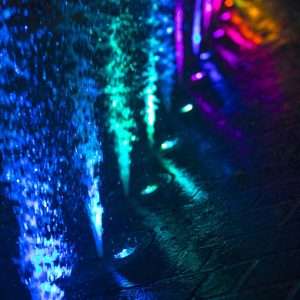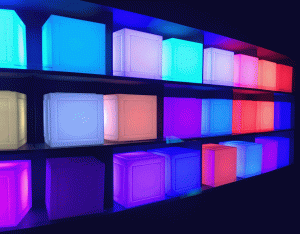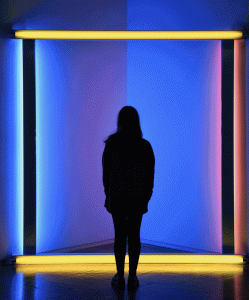How Do RGB LED Lights Change Color?
RGB LED lighting is becoming the latest in LED trends due to their energy-saving characteristic, ability to create vibrant colors (red-green-blue), excellent brightness, and flexibility to work in different applications such as commercial, landscape, and architectural. Apart from installing them indoors, the water-resistant feature also allows you to use them in outdoor settings.
RGB LED lights program colors to match your moods and for specific situations
With the advancement in technology, they come with several features like programmable options, remote control, smartphone app navigation features, and timer for the convenience of users to handle wirelessly at a distance and perform hassle-free functioning.
What are RGB LEDs?
White light are often produced by mixing different colored lights together, the most common method is to use the primary colours red, green and blue (RGB). These are the three primary colors of the additive color system.
As this mechanism involves the blending and diffusion of various colours, this approach is little used for the production of white lighting due to the tendency of it to have a slight tint or hue. However, this method is particularly interesting for effect applications because of the flexibility of mixing different colours.
In principle, most perceivable colours can be produced by mixing different amounts of these three primary colours, and this also makes it possible to produce precise dynamic colour control. With the use of the DMX control protocol, it is actually possible to achieve over 16 million color shades.
How does RGB LED work?
Well, on each colour scale it is possible to select 256 levels or shades of that colour. For example, if you have three primary colours and each one can have 256 different shades, then by mixing them together you can mathematically generate 16.7 million different colours.
255 x 255 x 255 = 16,581,375.
RGB LED controllers work on a much simpler principal. They change the power on each of the three channels (red, green and blue) to produce a specific colour mix.
To create purple colour, for instance, the red and blue channels would be wound up, and the green channel should turn off completely. Mixing blue and red light will give you the purple you are looking for. It’s not as precise as DMX, but adequate for most residential and commercial applications where cost may be a factor.
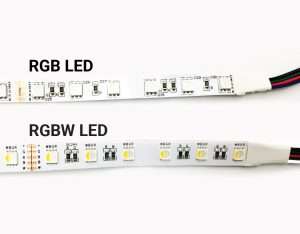
RGB is not the same as RGBW. Why?
Many people are confusing the difference between RGBW from RGB LED and why some are more expensive than others.
There is actually a couple of things worth considering, based upon the individual needs of the customer.
Basically, RGB is an LED chip that has the color red, green and blue; 3 colours in 1 chip. Using these, you can create a million different colours. For example, if you want to make purple, can use mostly blue and red. LED chips work the same way; one colour will be brighter than the others to create your desired colour.
But there is a downside when you want to create pure white tone. To make the white color, all 3 colours of your RGB LED need to be at maximum capacity. Nevertheless, this will create a low-intensity blueish white.
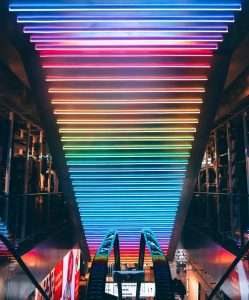
So, is RGBW better?
RGBW has an additional white chip, giving you that pure white when desired. The RGBW has 2 LED chips: RGB + W (white). As a result, your RGB chip will not be working to emulate white. Instead, the RGB chip will be turned off, and the white chip will be turned to 100%. Not only will this create a pure white, the intensity of your light will also be brighter and illuminate better.
Since the 2 LED lights can be turned on simultaneously, you can create many more different tones of white. The white and red can work together to create a beautiful warm white, or white and blue can create a cool white. The warmth temperature of the white will depend on your desire.
In addition, you can create higher intensity bright colours. The 2 LEDs can be turned on simultaneously to give you a really bright pink, red, green, yellow, or any other colour you select.
Since the RGBW is made up of 2 chips, you gain a wider range of hues for your colours and whites. RGBW is more flexible, allowing you to create the perfect ambient atmosphere and aesthetic for your designs.
It is necessary to think about the application if you want to choose between RGB and RGBW. Using RGB is sufficient for colorful decorative lighting or secret light band is required. RGBW will be the right choice for task lighting that requires bright white.
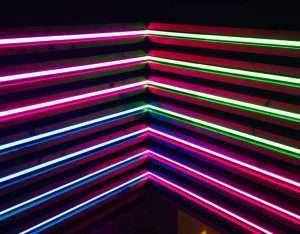
Types of RGB LED / RGBW LED Lighting Solution
We carry different types of color-changing RGB LED/ RGBW LED light fixtures, they are:
- RGB LED strip light
(EvoGreenTech’s project reference: Sri Hartamas, KL)
- RGBW LED linear light
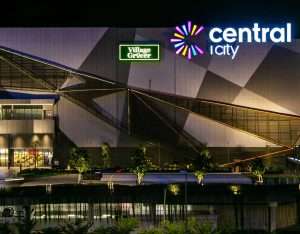
(EvoGreenTech’s project reference: Central i-City, Shah Alam) - RGB LED pixel light
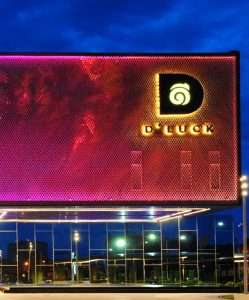
(Project reference from EvoGreenTech’s Thailand partner, Bangkok)
They can achieve different colors and dynamic effects by independently controlling the chips. In addition to the controller, their accessories are universal, including power supply, amplifier, etc. Here’s what we will cover in this article and boiling down into details.
Color Control System for RGB LED
DMX (Digital Multiplex Signal) is a digital-network communication standard that offers flexible control options for a wide variety of lighting, including LEDs. DMX has become the go-to choice for stage lighting, upscale venues, and complex lighting effects.
It gives your lighting equipment instructions on what to do and when to do it. It was originally implemented as a means of controlling light dimmers. But since then, its use has widened and advanced, and DMX is now used for all kinds of lighting and special effects for complex architectural and interior lighting.
If you’re going to install an LED project controlled by DMX, then it’s essential to understand how the standard works and what you need to run it at full potential. You’ll find the process interesting and perhaps equally challenging, but the end results are well worth the effort.
Why choose DMX?
For many designers, artists, and even architects, DMX has become the first choice for their lighting system requirements.
And for business owners and entrepreneurs who run big, customer-facing operations such as bars and restaurants, DMX is now recognized as one of the most convenient and practical options, as it allows full control of their lighting needs from a single centralized location.
What is a DMX ‘channel’?
Each DMX installation can control up to 512 channels. What does that mean in practice?
If you’re using RGB LEDs, then each color (red/green/blue) will need its own dedicated channel. Therefore to control one RGB LED (or a zone of RGB LEDs that are to be controlled/synchronized together), you’ll require 3x DMX channels. This means that a DMX universe of 512 channels is capable of controlling up to 170 separate RGB lights or lighting zones.
If you’re using single-color LEDs, then a single DMX universe is sufficient to control up to 512 LEDs or lighting zones.
Each lighting fixture in the DMX universe is addressed via a DMX decoder or driver. Once it’s set up, you’ll be able to program your light scenes by using the fixture’s unique DMX address.
How do you control DMX?
The design of a DMX installation begins by determining how many lighting fixtures/zones you wish to control respectively. This is because each fixture (or zone) needs its own DMX address, so a DMX decoder or driver unit can send instructions to control it.
For single-colour LEDs, all that’s required is a single channel to send instructions to dim or brighten your light, or to switch it on and off.
Adjustable LEDs that allow full color-control and color-mixing (e.g., RGB, RGBW, and dual-white LEDs) need a separate channel to control the relative brightness levels of each adjustable color. This is why an RGB fixture or lighting zone uses three of your 512 DMX channels.
What is a DMX controller for RGB LED?
To understand DMX, it is important to understand the DMX controller, where it fits in the installation, and how it works. DMX control was built for stage shows but, since then, its use has diversified to include LED lights which have enabled the same lighting techniques to be used in a wider range of projects and locations.
To achieve this, a DMX controller has four distinct control modes, as indicated below:
- Zone or Circuit Selection (enabling the selection of individually addressed units or circuits)
- Colour Selection
- Dimming or the fade control
- Program Selection
Programming the controller begins by selecting the unit or units you will be controlling. This depends on the DMX controller and the number of units you can control at any given time.
Once you have selected the unit(s) to be controlled, you can proceed to choose the color to be output by your LEDs. Some basic controllers use a rotary dial, while advanced DMX controls enable you to preselect the values that you want. After this, you can then set fading and dimming instructions for your LEDs on your controller. These instructions, along with the colors you selected before, will give you the lighting effect that you want.
The last step includes programmed effects. You can set these by choosing basic effects or programming effects that work for you in more advanced DMX models.
What is a DMX Decoder?
This is a controller receiver that manages the communications to your lighting fixtures. There’s no limitation on the number of receivers you can link together. In other words, you will not be limited to the number of lights you can control from a single controller.
DMX decoder is either controlled individually, or they can be grouped together in order to create the same colors and effects across lights controlled by multiple receivers. This kind of setup works best in public locations and venues, such as bars and restaurants. For these kinds of large projects, you will find a DMX decoder invaluable.
DMX allows the user to have control over multiple lighting fixtures, different areas, colors, and a huge range of other options.
When working with LEDs, though, you will always need a DMX decoder. The decoder serves to convert the DMX signal into a pulse width modulated (PWM) power source that can be interpreted by the LED.
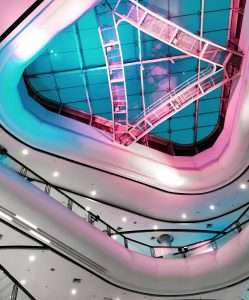
Programmable RGB LED Controller
ESA
DMX controlling LED lights is the most technical and powerful way to control LED lights. The lighting scene is created by computer software and then saved on the DMX controller for use in “Easy Stand Alone mode” or used outside of the computer.
MADRIX DMX Software
Madrix software is highly versatile and can take full advantage of today’s LED technology. Any 2D project can be integrated with 3D elements to create more fascinating attractions for the public. This software is a powerful tool allows to program of any type of LED installation. With the technology of DMX512 over Art-Net, unlimited address of control can be achieved.
Learn how to configure MADRIX here.
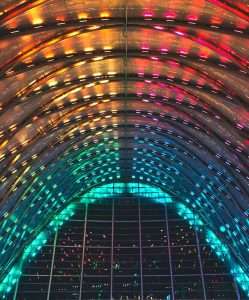
RGB LED Amplifier
An RGB Amplifier allows you to increase the size of your lighting installation where the overall wattage of the LED lighting you are using exceeds the load of the initial power supply. The amplifier works by boosting the amount of power supplied to the LEDs.
Each amplifier requires its own power supply, the size of which depends on the amount of LEDs you are aiming to power. For each amplifier, you will also require an additional power supply, which is sold separately.
The RGB Amplifier is easy to install and uses standard terminal block connectors.
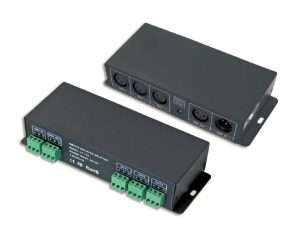
For instance, an RGB amplifier is perfect for long-run RGB strip light installs. It takes the signal off the first run of RGB lights and amplifies it to the next run. You need to connect the proper sized LED power supply to the amplifier in order to make it run correctly.
The amplifier is needed because of what is called “voltage drop”. So after longer lengths of LED strip light, the current drops off and makes the strips dimmer at the end of the run than at the beginning.
(EvoGreenTech’s project reference: realme Design Studio, Flagship Store)
Looking for any suggestions for your RGB LED project?
At EvoGreenTech, we always strive to exceed our customers’ expectations. There is no project that is too big or small. We have hundreds of satisfied customers and clients ranging from homeowners to restaurants, hotels, shopping malls, and public facilities.
Get professional support now! Contact us here.


